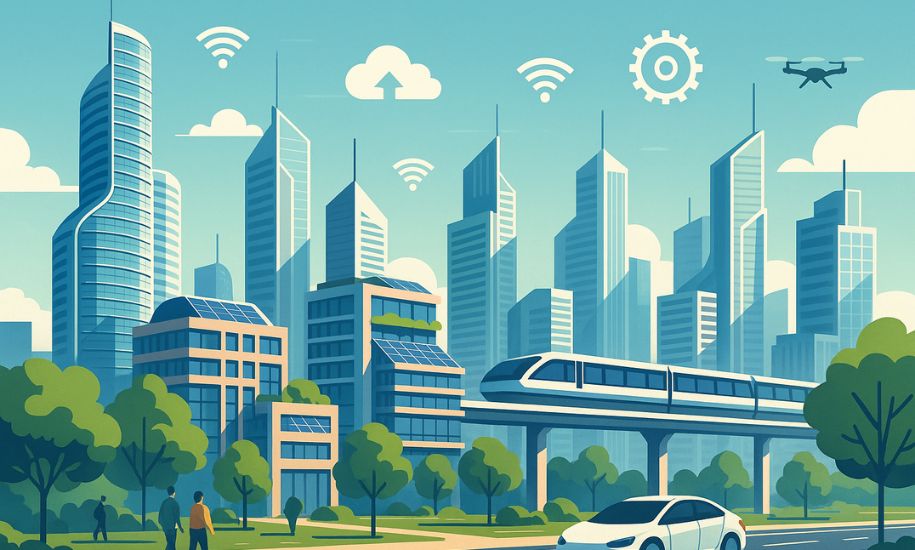The modern world is witnessing unprecedented urban growth. By 2050, it is estimated that over two-thirds of the global population will live in cities. This rapid urbanization brings challenges—climate change, congestion, housing shortages, environmental degradation—but also opportunities for rethinking how we live. This is where Axurbain steps in.
Axurbain is not just an architectural or city-planning concept—it is a holistic vision of cities that are sustainable, technologically advanced, socially inclusive, and resilient. This forward-thinking framework blends environmental stewardship, smart infrastructure, and human-centered design to create a new standard for urban living.
In this article, we’ll explore what Axurbain is, its design principles, technological pillars, challenges, and how it might shape the future of cities around the world.
What Is Axurbain?
Axurbain is a comprehensive urban model designed to harmonize the relationship between humans, technology, and the environment. It represents:
- Sustainable city design that integrates green spaces and renewable energy systems
- Smart infrastructure powered by artificial intelligence (AI) and the Internet of Things (IoT)
- Inclusive communities that prioritize well-being and accessibility for all
- Adaptive resilience to handle climate, economic, and social changes
It’s both a blueprint for planners and a philosophy for citizens, advocating that cities must be places where people can thrive—not just survive.
Core Principles of Axurbain
1. Sustainability as the Foundation
Axurbain cities are designed to minimize their environmental impact:
- Renewable energy: Solar panels, wind farms, and energy-efficient building designs reduce carbon emissions.
- Circular economy: Waste is minimized through recycling, composting, and product reuse.
- Green infrastructure: Vertical gardens, rooftop farms, and tree-lined streets improve air quality and urban biodiversity.
2. Human-Centered Urban Planning
People are at the heart of Axurbain’s design:
- Inclusive spaces: Public parks, cultural centers, and recreational areas accessible to all.
- Affordable housing: Mixed-income neighborhoods to prevent socio-economic segregation.
- Well-being focus: Community healthcare centers, wellness programs, and safe pedestrian pathways.
3. Smart Technology Integration
Technology drives efficiency and connectivity in Axurbain cities:
- IoT sensors monitor air quality, traffic flow, and waste management in real-time.
- AI algorithms optimize energy use, emergency services, and transportation schedules.
- Blockchain systems ensure transparency in governance, land use, and citizen engagement.
4. Innovative Mobility Solutions
Transportation in Axurbain is designed for convenience and sustainability:
- Autonomous electric vehicles reduce pollution and congestion.
- Car-free zones encourage walking, cycling, and public transit use.
- Mobility-as-a-Service (MaaS) integrates buses, trains, ride-sharing, and bike rentals into a single digital platform.
5. Resilient and Adaptive Infrastructure
Cities must be prepared for disasters and change:
- Climate-resilient buildings designed to withstand floods, heatwaves, and earthquakes.
- AI-driven disaster management for rapid emergency response.
- Flexible urban layouts that adapt to population growth and technological evolution.
The Technological Backbone of Axurbain
Artificial Intelligence (AI)
AI enables predictive city management:
- Anticipating traffic jams before they happen
- Adjusting energy distribution during peak demand
- Detecting environmental hazards early
Internet of Things (IoT)
IoT connects all aspects of the city:
- Smart streetlights that adjust brightness based on pedestrian activity
- Waste bins that signal when they’re full
- Public transportation that responds to passenger demand in real-time
Augmented & Virtual Reality (AR/VR)
AR/VR enhances community engagement:
- Virtual town halls for citizen participation
- AR navigation for tourists and commuters
- Digital twins of cities for simulation and planning
Blockchain
Blockchain ensures transparency:
- Secure land registry systems
- Transparent public budgeting
- Tamper-proof voting for local elections
Cultural and Social Impact of Axurbain
Beyond technology, Axurbain envisions cities as cultural hubs:
- Spaces for art, music, and cultural exchange
- Support for local artisans and small businesses
- Festivals and events that foster social connection
The emphasis is on community building—ensuring that technology serves people, not the other way around.
Global Inspirations for Axurbain
Although Axurbain is still largely conceptual, elements of its philosophy are visible in real cities:
- Singapore: Smart traffic systems, vertical gardens, and water recycling.
- Copenhagen: Cycling-first policies and renewable energy adoption.
- Toronto’s Quayside Project: AI-driven city design (although controversial).
These examples show that Axurbain’s vision is achievable—piece by piece.
Benefits of Axurbain-Style Cities
Environmental Benefits
- Reduced carbon footprint
- Improved air and water quality
- Increased biodiversity
Social Benefits
- Greater accessibility and inclusion
- Stronger community ties
- Improved public health and safety
Economic Benefits
- Attraction of global talent and investors
- Growth of green jobs and tech industries
- Reduced costs from energy efficiency
Challenges and Criticisms
1. High Initial Investment
Developing smart infrastructure and renewable systems requires substantial funding.
2. Technological Barriers
Not all communities have access to advanced technology or the digital skills to use it.
3. Privacy Concerns
Constant data collection from sensors raises questions about surveillance and data protection.
4. Risk of Gentrification
If not carefully managed, modernization may displace low-income residents.
The Future of Axurbain
In the coming decades, Axurbain could evolve from concept to reality:
- 2025–2030: Pilot neighborhoods adopting partial Axurbain principles.
- 2030–2040: Integration of AI, IoT, and green infrastructure in major global cities.
- 2040–2050: Fully adaptive, self-sustaining Axurbain cities.
The journey will require collaboration between governments, private sectors, and citizens.
Conclusion
Axurbain is more than an urban design concept—it’s a call to reimagine cities as sustainable, inclusive, and technologically advanced ecosystems. As urban populations grow and environmental challenges intensify, the Axurbain framework offers a balanced path forward—one where innovation meets humanity.
If implemented thoughtfully, Axurbain could transform city life into something healthier, more connected, and more equitable. And while we may not live in a fully realized Axurbain city yet, the blueprint is here—waiting for the visionaries, policymakers, and communities to bring it to life.
At Movies Mod, we believe in highlighting transformative ideas that could shape our collective future. Axurbain is one such vision—one worth following, supporting, and making a reality.
